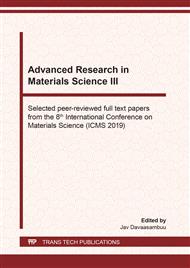[1]
M. Lines, A. Glass, Principles and applications of ferroelectrics and related materials, Clarendon Press, Oxford, (1977).
Google Scholar
[2]
Yu. Kuzminov, Lithium niobate and tantalate - materials for nonlinear optics, Nauka, Moscow, (1975).
Google Scholar
[3]
T. Volk, M. Wöhlecke, Lithium Niobate. Defects, photorefraction and ferroelectric switching, Springer-Verlag, Berlin, (2008).
DOI: 10.1007/978-3-540-70766-0
Google Scholar
[4]
P. Ferraro, S. Grilli, P. De Natale, Ferroelectric crystals for photonic applications, Springer-Verlag, Berlin-Heidelberg, (2009).
Google Scholar
[5]
D. Sinclair, A. West, Electrical properties of a LiTaO3 single crystal, Physical Review B 39 (1989) 13486-13492.
Google Scholar
[6]
Y. Jinfeng, M. Qianhui, S. Jifang, Preparation and characterization of thick stoichiometric lithium tantalate crystals by vapor transport equilibration method, Materials Letters 232 (2018) 150–152.
DOI: 10.1016/j.matlet.2018.08.105
Google Scholar
[7]
T. Feng, L. Siwei, Y. Xin et al., Optimization of pyroelectric figures of merit via magnesia doping in lithium tantalate single crystal, J. of Physics D: Applied Physics 51 (2018) P 395101.
DOI: 10.1088/1361-6463/aad88d
Google Scholar
[8]
A. Vyalikh, M. Zschornak, T. Kohler et al., Analysis of the defect clusters in congruent lithium tantalite, Physical Review Materials 2 (2018) P 013804.
Google Scholar
[9]
V. Pryakhina, E. Greshnyakov, B. Lisjikh, As-grown domain structure in lithium tantalate with spatially nonuniform composition, Ferroelectrics 525 (2018) 47‒53.
DOI: 10.1080/00150193.2018.1432926
Google Scholar
[10]
A. Buzady, M. Unferdorben, D. Toth et al., Refractive Index and Absorption Coefficient of Undoped and Mg-Doped Lithium Tantalate in the Terahertz Range, J. of Infrared Millimeter and Terahertz Waves 38 (2017) 963‒967.
DOI: 10.1007/s10762-017-0393-y
Google Scholar
[11]
L. Kyu-Sup, K. Do-Kyeong, E.Y. Nan, Temperature-dependent Sellmeier equation at terahertz frequency range for 1 mol % MgO-doped stoichiometric lithium tantalite, Japanese J. of Applied Physics 56 (2017) Р 040303.
DOI: 10.7567/jjap.56.040303
Google Scholar
[12]
Z. Xiaoling, Y. Ming, L. Mengxue, Comparison of broadband second-harmonic generation in periodically poled stoichiometric lithium tantalate with different magnesium oxide doping concentrations, J. of Optoelectronics and Advanced Materials 18 (2016) 613‒617.
Google Scholar
[13]
S. Masloboeva, M. Palatnikov, L. Arutyunyan et al., Obtaining and studying microcrystalline powders of lithium niobate and tantalite, Physical and chemical aspects of the study of clusters, nanostructures and nanomaterials (Tver: Tver State University) 8 (2016) 239‒246.
DOI: 10.26456/pcascnn/2019.11.478
Google Scholar
[14]
H. Ichioka, S. Furuya, T. Asaka Crystal structures and enhancement of photoluminescence intensities by effective doping for lithium tantalate phosphors, Powder Diffraction 30 (2015) 326‒332.
DOI: 10.1017/s0885715615000688
Google Scholar
[15]
I. Levina, Z. Shapiro, V. Shishov, Methods for the synthesis of methaniobates and metatantalates of alkali metals, Inorganic glasses, coatings and materials 2 (1975) 144‒151.
Google Scholar
[16]
G. Janson, I. Vinogradova, H. Zanetskite et al., Formation reactions and properties of alkaline tantalates, Inorganic glasses, coatings and materials 2 (1983), 137-147.
Google Scholar
[17]
M. Palatnikov, N. Sidorov, V. Kalinnikov, Ferroelectric solid solutions based on oxide compounds of niobium and tantalum: synthesis, study of structural ordering and physical characteristics, Nauka, St. Petersburg, (2002).
Google Scholar
[18]
S. Masloboeva, I. Elizarova, L. Arutyunyan et al., Synthesis and study of a mixture of lithium tantalate doped with rare-earth elements, Reports of the Academy of Sciences 460 (2015) 427‒431.
DOI: 10.1134/s0012501615020037
Google Scholar
[19]
S. Masloboeva, G. Duboshin, L. Arutyunyan, Studies on the production of potassium heptafluorotantalate from fluoride-sulphate solutions, Vestnik MSTU 12 (2009) 279-285.
Google Scholar
[20]
R. Hsu, E. Maslen, D. du Boulay et al., Synchrotron X-ray Studies of LiNbO3 and LiTaO3 Acta Crystallographica Section B: Structural Science 53 (1997) 420‒428.
DOI: 10.1107/s010876819600777x
Google Scholar


